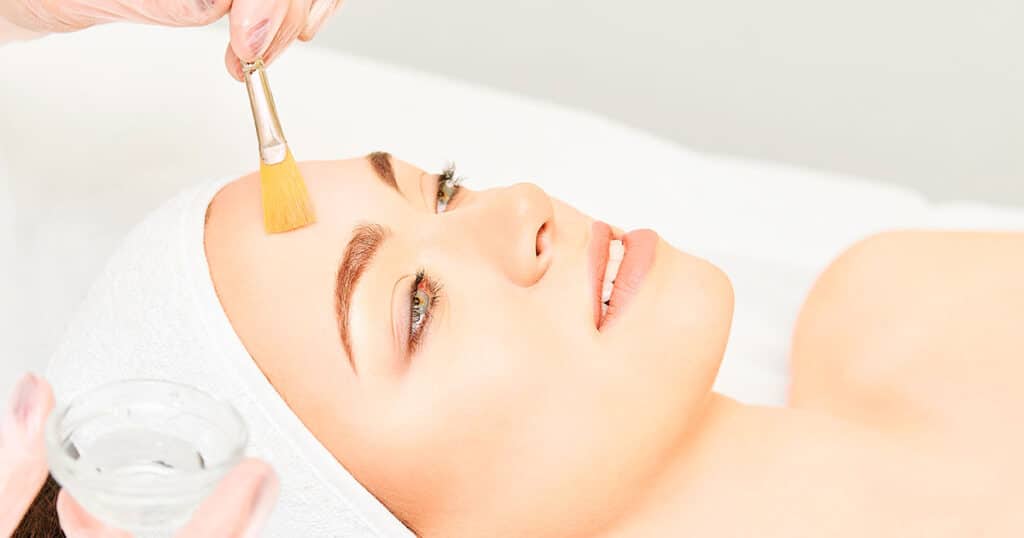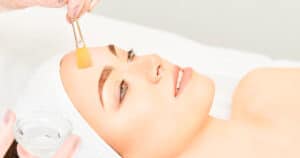What does chemical peeling of the skin mean?
Chemical peels are very effective methods for treating many different kinds of skin issues. An effective chemical peel renews the skin incredibly quickly and effectively.
What are the effects of a chemical peel?
All types of chemical peeling accelerate the natural renewal of skin cells and the removal of dead cells, i.e. the cornified layer of skin. The rough, lifeless layer on top of the skin is removed while strengthening the dermis, which guarantees the vitality of skin. Chemical peels give fast and visible results – the skin becomes clean and soft and its texture, surface and colour improve.
In which cases is it not possible to do a chemical peel?
- broken skin (due to e.g. shaving, frequent nose blowing or other reasons)
- herpes (unless internal preventive medication has been started 2 days before peeling)
- general illnesses (infections, fever)
- taking Roaccutan
- pregnancy
Which treatment, how often and how many sessions?
Depending on the type of skin and issue, gentler or more intensive methods can be selected. The treatment method is always chosen together with the cosmetologist. To achieve the desired results, chemical peeling is recommended as a series of 4–6 treatment sessions every 2–4 weeks.
In which cases is chemical peeling recommended?
- oily skin and skin inflammations
- problematic and acne-prone skin
- rosacea
- seborrheic dermatitis
- ageing skin (uneven or inelastic skin)
- skin that needs stimulation
- dryness of skin
- sun damage
- ichthyosis
- couperose
- uneven skin texture
- enlarged pores
- keloid and hypertrophic scars
- deep wrinkles
- pregnancy stretch marks
- pigmentation issues
- hyperpigmentation
- melasma, i.e. “age spots”, “liver spots”
- freckles
- hypopigmentation
- vitiligo or leucoderma
What does the skin look like after chemical peeling?
On the day after a chemical peel, the skin may be red and swollen. On the second day after an acid peel, skin may become brownish. The peeling of dead skin cells usually starts from around the mouth and nose on the third day after a chemical peel. The peeling of skin usually lasts for 2–3 days. It is also entirely possible not to have any visible or noticeable symptoms. This does not mean that the treatment was not successful, however. Microscopic peeling definitely happens after the treatment. It is just not visible to the naked eye.
Please also read important further information on chemical peels and our other facials on our page with information on facials.

What things I can or cannot do after a chemical peel?
- only use skin care products intended for the purpose
- protect yourself from the sun (4–8 weeks, SPF 50+)
- do not go to the solarium (for 4–8 weeks)
- do not go to the sauna, steam sauna or swimming pool
- do not remove the peeling skin mechanically (exfoliating, tearing flakes off)
- do not use active cosmetic substances
- do not do intensive exercise or sports – microscopic blisters will form under the dry skin
- do not remove hair from the treated area
- do not have any cosmetic treatments done
What kind of skin reactions are normal after a chemical peel?
- the skin may be tender to the touch
- the skin may become red
- the skin may become brown
- the skin may sting/tingle/prickle/itch
- the skin may peel even heavily
- the skin may become swollen
- even water may sting on the skin
- care products may sting on the skin
When coming to a chemical peel, please keep in mind that…
- The treatment may cause (visible or invisible) peeling of the surface layer of the skin.
- The skin care you do after the treatment affects the end result.
- It is important that you use the specific products recommended to you by the cosmetologist.
- We cannot guarantee the results of the treatment or give accurate estimates on discomfort or how long the skin will feel.
- During the treatment, you may feel temporary prickling or burning on your skin. This will pass in just a few minutes.
- During the next couple of hours, your skin may start to feel a little tight; this feeling may last for several days.
- For most customers, the skin begins to peel within 48 hours.
- It is impossible to tell in advance how much the skin will peel.
- The peeling process usually lasts for 5–7 days.
- Depending on the peeling treatment used and your skin type, the following reactions are possible:
- Extended redness, irritation and peeling of the skin
- Dryness and sensitivity
- In some rare cases, strong allergic reactions.





